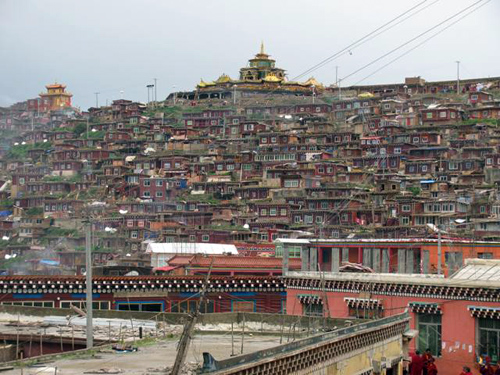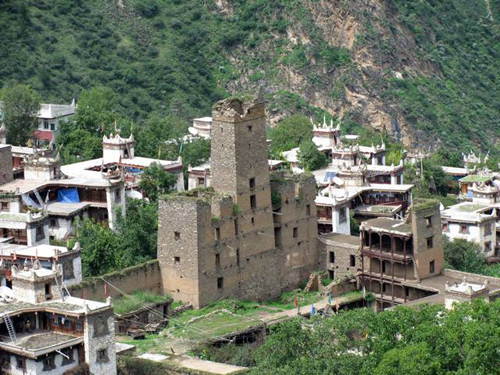
August 2009
John Vincent Bellezza
Finally, here it is: the latest issue of Flight of the Khyung! My travels in eastern Tibet delayed publication by more than two weeks. It has been three years since this newsletter was first published, a forum for pressing Himalayan issues and concerns, as well as a log of my most recent travels and activities. As always, your comments are welcome. If there is anything in Flight of the Khyung you would like to add to or take exception with, kindly make your views known to me.
To the Opposite Side of the Tibetan Plateau
As many of you know, most of my travels in Tibet take place in the western half of the Plateau. However, over the last five weeks, I have traveled in Kham (Tibetan = Khams), Gyalrong (rGyal-rong), Amdo (A-mdo), and Golok (’Go-log), regions in eastern Tibet. In modern administrative terms, my peregrinations spanned the Kanze (dKar-mdzes) and Ngawa (rNga-ba) prefectures of Sichuan province. These traditional Tibetan lands provide the savvy traveler with an incredibly rich cross-section of culture and history.
Save for a brief visit in 1991, this was my first time in Kham. It was well worth the effort to get there, as anyone who has come to the region will know. Divided between the three Chinese provinces of Sichuan, Yunnan and TAR, it is a region of spectacular architecture and scenery. The center point of my wanderings was the regional breadbasket of Kanze, a temperate basin situated 3400 m above sea level. A number of important Buddhist monasteries grace its barley growing communities. On the east side of the Kanze basin is the acropolis of Beru, the capital of a Bon kingdom that was conquered by the Mongol general Gushri Khan on behalf of his Gelukpa preceptors in 1639–1641 CE.
As I was to learn, the remaining Bonpo in Kham and other eastern Tibetan regions are still quite sore over the loss of much of their ecclesiastic territory. Times change and with them the fortunes of religions; you can either be philosophical or not about such things. In any case, the gargantuan changes of this modern period have served to unify disparate Tibetan groups like never before. Irrespective of caste, language and sect, all those who practice Tibetan religion are increasingly finding a common sense of identity and purpose.
To the east of Kanze is Derge (sDe-dge), often considered the cultural capital of Kham. Undoubtedly, the nucleus of Derge is the Derge Parkhang, the largest surviving xylographic printing house in Tibet. Founded by King of Derge Tenpa Tsering in the early 1700s, the Derge Parkhang once boasted 1000 monks. With more than 200,000 wood blocks, this august facility has played a crucial role in the propagation of Tibetan culture and Buddhism for three centuries. Several dozen workers are still employed in producing printed works. They work in pairs exhibiting great agility, printing two sides of a folio in only a few seconds. The men apply the ink to the long sheets of paper with just a couple of fluent movements. The best quality paper for printing is made in the time-honored way from the root of Stellaria flowers, lovely globes of white and red florets. At the nearby Sakya monastery of Derge Gonchen, I carried a heavy bag of earth to the construction site of a chapel, to the cheers of scores of people laying down the rammed earth walls of the structure.
In Serta (gSer-rta), a town that borders Kham, Amdo and Golok, I made a speech to the delight of a fancy wedding party. Serta is renowned for its great Nyingma religious center, an astounding sight. Hillside after hillside is carpeted in the red log cabins of monks and nuns, a veritable crimson city spread beneath the deep blue sky. This is by far the largest single Buddhist community on the Tibetan Plateau. Practitioners from every sect and part of Tibet come to Serta to receive religious instruction and inspiration. The holy city was founded by the late Jikme Phuntsok, a lama, by all accounts, of tremendous charisma and insight.

A section of the Serta monastic center
Amdo Ngawa (rNga-ba) is another great monastic hub with ecumenical tendencies. Located near the county seat is the Gelukpa Kiti (Ki-rti) Gonpa, a sprawling complex with some 3000 monks. On the opposite end of town is Se (bSe) Gonpa, a well-run institution belonging to the tiny Jonangpa sect (reportedly, it only has 50 monasteries all told, 46 in Amdo and 4 in Central Tibet). The Bonpo are most strongly represented in Ngawa by Nangshik (sNang-zhig) monastery, some 800 strong. Nangshik was founded approximately 800 years ago, making it older than Menri, in central Tibet, to which it is affiliated.
Towers Touching the Sky
Gyalrong is a region of luxuriant forests, deep gorges and the most idyllic valleys imaginable. I had hoped to locate illuminated Bon funerary texts in Gyalrong, but did not have success. I sought out Tibetan speakers but there are not many of them, the Gyalrong languages being neither Bodish nor Bodic. Despite the language barrier, the trip was certainly not wasted, as there was much to see and learn. The people of Gyalrong are gentle and friendly, making travel there easy and pleasurable. I visited a number of their monasteries. These tend to be tiny affairs; most have only a small handful of monks and virtually no young novitiates.

Rabten Gyalpo towers
In the Khyungsang (Khyung-bzang) valley, I climbed up to the ruined complex of Rabten Gyalpo (Rab-brtan rgyal-po), one of the 18 royal lines of Gyalrong. This imposing 18th or 19th century complex is dominated by three high towers, the central one rising to nine stories. These square plan towers exhibit various types of stonework, all of which is of a high order of workmanship. Masonry courses were wedged in between the three tapering towers to improve their stability. Referred to as khar (mkhar = castle), the towers are flanked on three sides by open galleries abutting a series of apartments up to four stories in height.
The towers of Khyungsang have much to tell us about the tradition of tower architecture in Gyalrong. They are thought to have been constructed as symbols of prestige and temporal power, acting as a fastness where the propitiation of protective deities was carried out on behalf of the royal family. On an outer wall of the chapel connected to the tower complex there are murals of the main territorial deities of the region. These include Nechen Gyalrong Muta (gNas-chen rgyal-rong mu-rta/dmu-rdo) and his consort, Nyencam Karmo (gNyan-lcam dkar-mo). In the Khyungsang murals, Gyalrong Muta is a white warrior god who sits astride a snow lion. In his right hand he brandishes a spear with flag and in his left hand he clutches a flaming jewel. Nyencam Karmo, the rider of a female hybrid yak, is attired in colorful robes. She grasps a draped arrow in her right hand and a mirror in her left. It appears that this prototypic divine couple of Gyalrong played a big role in the ritual dispensations carried out in the Khyungsang towers.
One of my best informants in Gyalrong was Sherab Lekden of Bhola, a Bon monastery situated above the town of Barkham. He and other Bon monks believe that even the most ancient towers in the region (founded no later than the 12th century CE) were originally constructed as places of worship, particularly for the personal and territorial deities. The burning of incense is said to have constituted the most common ritual practice. Some of these ancient ritual structures are six-sided or star-shaped. Later, certain towers came to assume military value, but this appears to have been a secondary function. Seeking tactical advantage, Gyalrongwa are said to have used the towers for small armed encounters, particularly during 18th century battles against marauding Manchus.
The religious or ceremonial function of the Gyalrong towers is borne out by their geographic positions. Although a good proportion of them occupy high slopes and ridgelines, they possess very little inherent strategic value. They were potentially outflanked by an enemy approaching from higher ground. Moreover, the towers are usually isolated structures; they are not walled in or appended to other defensive structures. Consequently, they possess very little strategic depth, making them vulnerable to the siege tactics of a determined enemy.
The traditional domestic architecture of Gyalrong supports the view that the ancient towers had a religious/ceremonial function. The houses of the region include turrets that are three and sometimes four stories tall. The top story of this integrated structure is known as a choekhang (chos-khang), and is where the household and territorial deities are propitiated (although many households now have a Lamaist chapel within the main body of the house, as is customary in most places in Tibet). The rooftop chapels are surmounted by divine white stones known as labtse (la-btsas) or mudo (dmu-rdo). The free-standing ancient towers appear to be the direct architectural predecessors of the domestic turrets. When the ancient towers are surveyed, it would behoove investigators to search for traces of the divine white stones. Their presence would confirm the religious orientation of these noble monuments.
Increasingly, Gyalrongwa intellectuals are of the opinion that their origins, at least some of them, can be traced to Zhang Zhung. It is theorized that with the fall of the Zhang Zhung kingdom in the 7th or 8th century, displaced peoples from Upper Tibet migrated east to the valley sanctuaries of Gyalrong. Here they could pursue their ancient traditions unmolested by the Tibetan imperial state and Buddhist missionaries. Briefly, the evidence adduced to back up this claim is as follows: 1) the old oral tradition of Gyalrong that speaks of Zhang Zhung origins; 2) the presence of Zhang Zhung or Zhang Zhung-like words in Gyalrong languages; 3) a phonological system in the Gyalrong languages that shares much in common with Ladakhi and Balti of western Tibet; and 4) the predominance of Bon traditions in the region.
Now, presupposing that Zhang Zhung cultural influences are indeed embedded in the culture of Gyalrong, I would like to present the following hypothesis regarding the origins of the towers. As readers will know from my publications and those of other scholars, celestial and meteorological deities occupied an important place in the pantheon of Zhang Zhung. I suggest, therefore, that the towers of Gyalrong were constructed to project the ritual venue up into the sky. By building high towers, the Gyalrongwa attempted to mimic the open or skyward aspect of lofty Upper Tibet. The word for the firmament in Gyalrong, dmu, as well as the importance of the class of uranic deities in the region called dmu/mu, seems to support the idea that the ancient towers did indeed have celestial connotations.
Frederique Darragon
My friend, Ms. Frederique Darragon of Paris has been assiduously documenting the towers of eastern Tibet for over a decade. Her work has very significantly added to what we know about these curious structures. She is now deeply involved in trying to protect them for posterity. Due to her indefatigable efforts, local government officials and the public at large are finally realizing that they have world class ancient monuments in their backyard. I urge anyone intrigued by the towers of eastern Tibet to obtain copies of Frederique Darragon’s publications as well as her TV documentary, Secret Towers of the Himalayas.